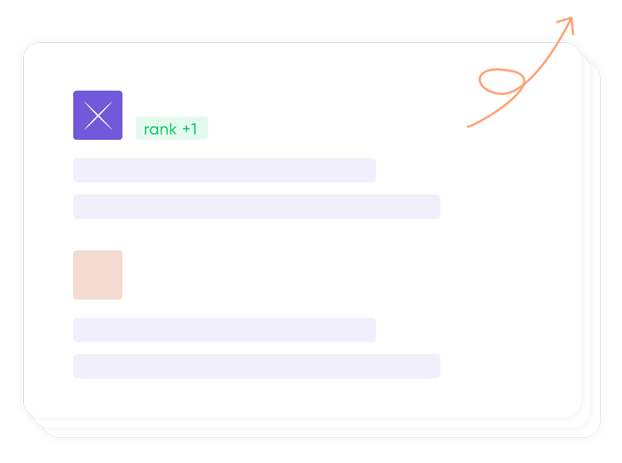One place and everyone you need from Product Designers, Product Managers to DevOps and Full-stack developers. Our web development team is active through the project with improvement suggestions in areas such as search engine optimization (SEO) or solutions that brings conversion. We make websites fast, on time and on budget.
Web development is not only about websites. It also means modern applications that meet the latest standards in SEO and marketing.

Good quality attracts user attention and helps build trust in your brand. Make sure your website or application is properly optimized for search engines (SEO), marketing, mobile devices, and meet your business challenges.
Work with our experienced development team and grow you better.
During the development process, we use all the information on best practices and policies of web development to make your project a success. Some companies have been working with us for over 6 years.
We are grateful Prixamo for 6 years of successful cooperation. The delivered solutions met all our requirements.
Maciej Krawczuk
Board Member at IPF Polska
Web development is the process of creating websites and web applications that can be accessed through the internet. It involves the use of various programming languages, for example HTML, CSS, PHP or JavaScript to build the structure, design, and functionality of web pages.
Web development can range from simple static websites to complex web applications that require server-side programming and database integration. The development process typically involves a team of web developers, designers, and other specialists who work together to create a website or web application that meets the needs of its intended audience.
Web development can be categorized into two main types: front-end development and back-end development.

Front-end is the part of the process of creating websites or web applications that focuses on creating the user interface and all elements visible to the end user.
The main goal of front-end is to create an aesthetically pleasing and intuitive interface that enables users to easily use the website or web application. Front-end involves working with programming languages such as HTML, CSS, and JavaScript, as well as libraries and frameworks such as React or Angular, which allow for easier creation of interactive interface elements.
Front-end developers create layouts, styles, graphics, animations, responsiveness, as well as functionality such as forms, buttons, and other interactive elements. Their goal is to create a comfortable and attractive interface that meets the needs and requirements of users.
Front-end is the entire process of creating and implementing the visible part of a website or web application that allows users to interact with the site or application.
Back-end is a web development process that focuses on programming and database management, as well as all elements responsible for server operation and support.
The main goal of back-end is to provide stability, performance, and security of a website or web application by ensuring proper server-side functionality. Back-end developers use various programming languages such as PHP, Ruby, Python, or Java, as well as frameworks and libraries such as Node.js or Django.
Back-end developers are also responsible for creating and managing databases and creating application programming interfaces (APIs) that allow data exchange between the front-end and back-end.
Back-end is a part of the web development process that is responsible for programming and managing the server, database, and application programming interfaces to ensure stability, performance, and security of a website or web application.
Front-end is the part of the process of creating websites or web applications that focuses on creating the user interface and all elements visible to the end user.
The main goal of front-end is to create an aesthetically pleasing and intuitive interface that enables users to easily use the website or web application.
Front-end involves working with programming languages such as HTML, CSS, and JavaScript, as well as libraries and frameworks such as React or Angular, which allow for easier creation of interactive interface elements.
Front-end developers create layouts, styles, graphics, animations, responsiveness, as well as functionality such as forms, buttons, and other interactive elements. Their goal is to create a comfortable and attractive interface that meets the needs and requirements of users.
Front-end is the entire process of creating and implementing the visible part of a website or web application that allows users to interact with the site or application.
Back-end is a web development process that focuses on programming and database management, as well as all elements responsible for server operation and support.
The main goal of back-end is to provide stability, performance, and security of a website or web application by ensuring proper server-side functionality. Back-end developers use various programming languages such as PHP, Ruby, Python, or Java, as well as frameworks and libraries such as Node.js or Django.
Back-end developers are also responsible for creating and managing databases and creating application programming interfaces (APIs) that allow data exchange between the front-end and back-end.
Back-end is a part of the web development process that is responsible for programming and managing the server, database, and application programming interfaces to ensure stability, performance, and security of a website or web application.
Creating a website or web application you need to consider many elements to ensure users have the best experience and make it easy for them to use your site or app. Here are a few things to keep in mind:
These are just a few important things to consider, but remember that the key aspect of creating a good website is always thinking about users and their needs.
Our developers can build from scratch or join and improve existing solutions helping your business grow.
Choose scalable and flexible technologies that fit to your business and work for international businesses
Laravel
Node.js
Vue.js

Nuxt.js
JavaScript
RESTful
AWS
SOAP